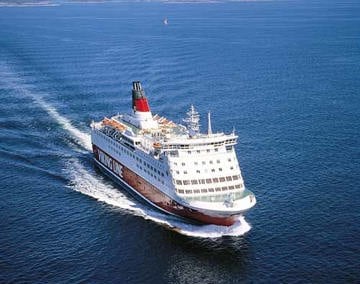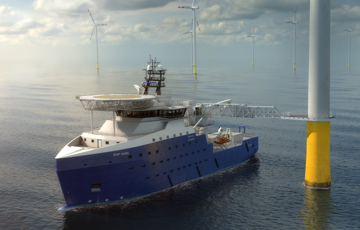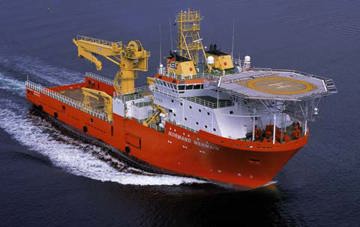
The Azipull Thruster is 20 years old. Its future is looking brighter
For over 20 years, the Azipull Thruster has proved its worth among ferry operators and offshore vessel owners. With the arrival of electric propulsion and stricter emissions regulations, this innovative system has an even better future among a wide range of ship types
In April 2003, just over 20 years ago, the world’s first Azipull (Azimuth Pulling) propeller system hit the water for sea trials on a double-ended aluminium catamaran ferry (FerryCat™), where the system was installed. These tests marked the beginning of an era for one of the best propulsion product series in the market.
“These compact and environmentally friendly units have become an industry standard among several operators,” says Juha-Pekka Vesa, Manager Products, Azipull.
The design challenges of the first Azipull thruster
The new system was based on the concept of having a forward-facing propeller on an azimuth pod. But Azipull offered some significant new features that hadn’t been seen in the market before.

Azipull thrusters offered a radically new design shape
The system allowed ship designers and yards to choose controllable pitch propellers (CPPs) as well as fixed pitch propellers. This gave vessel buyers more options for motor types, which is key to the operational flexibility of a vessel.
A tail-fin was also added, which was a new feature on an azimuth thruster with pulling propeller at the time. This contributed to a significant improvement in the steering efficiency for vessels driven by Azipull thrusters.
Azipull also offered a radically new design shape. The Azipull system’s designers knew they had to find much higher levels of hydrodynamic efficiency to create a breakthrough product that could truly stand the test of time.
“The initial learning curve was steep. While the CAD tools were not as powerful as they are today, we were still able to create a shape that could be manipulated and changed during design iterations"
To achieve this goal, a team of hydrodynamics experts, engineers, and CAD designers started working together in 1998 to create a shape for the entire unit that would provide next-level performance standards. This was crucial to the long-term success of Azipull, and it pushed the design team to the limit.
“The initial learning curve was steep,” says Kongsberg Maritime’s Jens Inge Ringstad, who was then a CAD manager. “While the CAD tools were not as powerful as they are today, we were still able to create a shape that could be manipulated and changed during design iterations.”
The slender thruster-body design had to achieve a clean propeller in-flow, with the leg and tail-fion optimised for a smooth flow pattern to attain high efficiency through recovery of the energy in the swirling flow from the propeller slipstream.
Proving the value of Azipull
The initial sea trial results of the Azipull system proved the value of the concept. FerryCat™ had a capacity for 120 cars and 252 passengers. With four Azipull thrusters, it achieved a maximum speed of 21.8 knots fully loaded, making it the world’s fastest double-ended ferry at the time.

The first-ever installation of an Azipull Thruster in 2003 on the FerryCat™
More proof of the Azipull series’ effectiveness would come quickly from the offshore market.
In 2004, two larger versions of Azipull units with controllable pitch propellers were retrofitted onto an offshore supply vessel, Bourbon Tampen, which had been using traditional azimuth thrusters. After just seven months, Bourbon Tampen’s operator reported a reduced fuel burn of approximately 50m3 per month, corresponding to a saving of 16.6%, with an annual reduction of CO2 and NOx emissions of 1700 and 35 tonnes, respectively.
The new Azipull thrusters continually demonstrated excellent rudder efficiency and low speed manoeuvrability – especially when equipped with controllable pitch propellers. Refit projects saw efficiency gains of 10% or better.
To date, 610 Azipull units have been delivered to about 300 vessels, an average of 30 systems per year. In 2017, the first Azipull-L thruster, using permanent magnet (PM) technology, was used as the main propulsion system for the 140m Hurtigruten expedition ships Roald Amundsen and Frithjof Nansen.
The Azipull thruster has been very popular for offshore support vessels, as well as ferries, product tankers, superyachts, cruise/passenger vessels and naval vessels.
“After 20 years of evolution, the Azipull system is today better than ever,” says Juha-Pekka Vesa. “The Azipull is still at the top in terms of propulsion efficiency as well as crew and passenger comfort due to its advanced hydrodynamic design.”
The future of Azipull thrusters
The future of Azipull thrusters looks even brighter as electrification or hybrid propulsion become more prevalent on commercial vessels. One of the original arguments for the development of the Azipull thruster was the flexibility it offered ship owners about the power source.

Azipull has been popular with offshore service vessels
In 2013, ten years after the launch of FerryCat™, Fjellstrand shipyard launched the ZeroCat™120, the world’s first all-electric ferry, derived from the work done on FerryCat™. Of all the vessels equipped with Azipull thrusters, 275 have fully electric drive lines, while seven have recently been delivered with hybrid-electric drivelines.
Rune Garen, formerly the SVP for Business Development at Kongsberg Maritime, was the R&T Director when the Azipull was originally developed.
“The Azipull has proven to be a great compromise between manoeuvrability, propulsive efficiency and cost in a world where the focus on energy consumption have become crucially important"
“The Azipull has proven to be a great compromise between manoeuvrability, propulsive efficiency and cost in a world where the focus on energy consumption have become crucially important,” says Garen. “No one believes the global market will converge to only one ship design and one propulsion solution. There will always be a need for different propulsion arrangements suited for vessels with different performance criteria and operating profiles.”
IMO regulations are tightening, and emissions targets are looming. Ship owners and operators are looking for solutions to cut emissions and demonstrate fuel savings. And with the growth of demand for offshore vessels for wind farm installation, there will be more need than ever for efficient manoeuvring among owners.
They may consider the Azipull thruster, which first entered the water 20 years ago, as a big part of their 20-year timeline for the future.


